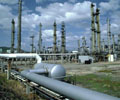US Gulf of Mexico deepwater oil, gas activity may increase

More deepwater exploration and project sanctions in the US Gulf of Mexico could be in store for the E&P sector during 2022 assuming robust oil prices hold up, according to analysts.
The roughly 12 deepwater US Gulf discoveries scored in 2021 could expand by a couple more next year, and several fields that have patiently waited out several years of price volatility may finally be greenlighted, said Sami Yahya, senior energy analyst-supply and production for S&P Global Platts Analytics.
“We could potentially see more finds and final investment decisions next year,” Yahya said. “US Gulf operators still have a healthy appetite for exploration, particularly as crude prices remain robust.”
“Near-field exploration [around deepwater production hubs with declining output] will likely continue to be the leading strategy,” he said. “[This] not only improves the economic case of new discoveries but can also help accelerate development, given existing infrastructure and the expected short-cycle time for tiebacks.”
Current US Gulf oil output is 1.769 million b/d, according to the latest Platts Analytics estimates. Output will likely to rise by as much as 125,000 b/d early in 2022 and end the year at 2 million b/d.
The three largest projects in the Gulf which are set to come online in 2022 are Shell’s Vito field, BP’s Mad Dog Phase 2 and three fields operated by Murphy Oil: Khaleesi, Mormont and Samurai.
“This is the first time in a while we’ve seen three new facilities come on in one year,” said Mfon Usoro, US Gulf of Mexico upstream analyst for Wood Mackenzie.
Mad Dog Phase 2 will also feature a new production hub named Argos with 140,000 b/d of gross oil capacity, and Vito also will sport new output infrastructure that can produce 100,000 boe/d at peak.
Debut of King’s Quay
The three Murphy fields will produce into a new 80,000 b/d production hub known as King’s Quay. Khaleesi and Mormont will deliver first oil in H1 2022 and Samurai in H2 2022.
The hubs can be later used to accommodate future production from yet undiscovered fields located within a roughly 30-mile radius.
Vito was pegged to come online in 2021, but concerns over the pandemic led to Shell postponing its debut.
Mad Dog Phase 2’s original cost was more than $20 billion, but by simplifying and standardizing its platform design the overall cost was lowered to $9 billion. At its December 2016 sanctioning it was projected to be profitable at around $50/b.
Besides the larger projects, a few smaller fields are expected to debut in 2022, all tiebacks or hook-ups to existing infrastructure. Two from privately held Gulf player LLOG Exploration are Taggart, which will tie into the Devil’s Tower, and Spruance, which will hook up to the Lobster facility, said Mark Adeosun, senior analyst-offshore for Westwood Global Energy Group.
In addition, Shell’s Power Nap field, producing 35,000 boe/d of oil at peak, will tie into the major’s Olympus platform.
“Basically, this is the use of existing facilities … [and] optimizing facilities, which always drives down development costs as well as breakeven prices,” Adeosun said.
Besides new field production, several discoveries are expected to be sanctioned in 2022, including Chevron’s Ballymore, a field in the emerging Norphlet geologic play off East Louisiana/Mississippi that was pioneered by Shell. Shell’s Rydberg field, also in the Norphlet, is also being watched for potential 2022 final investment decision.
Sub-$40/b breakevens
“I think the reason we’re bullish on those projects moving forward, is the economic criteria; they’re all sub-$40/b breakeven,” Usoro said. “They look healthy enough in today’s market to get sanctioned.”
Two other projects that could get the thumbs-up in 2022 include TotalEnergies’ North Platte field, an ultradeep play first discovered in 2012, and LLOG’s Leon/Castile fields, although some expect the FID could slip into 2023.
In addition, Shell’s Blacktip field and a related discovery earlier this month, Blacktip North, could be moved up the development queue, Usoro said.
“Shell has made some really material discoveries in the Perdido area,” a remote area of the southwest US Gulf, she said. “I wouldn’t be surprised to see them moving up the ranking … post-2022” to be considered for FID.
2021 was also productive for the US Gulf, as several projects operated by majors came online, including the September extension to a major BP field, Thunder Horse South Expansion Phase 2. The project added 25,000 boe/d at peak to the giant Thunder Horse field, one of the largest in the US Gulf, with production capacity of 250,000 b/d of oil and 200,000 Mcf/d of natural gas.
A year of tiebacks
But mostly it was a year of tiebacks, smaller fields hooked into existing production hubs with dwindling production from the original large field. For instance, Murphy’s Calliope tied into BP’s Na Kika production facility, and LLOG’s Praline tied into Talos Energy’s Pompano output hub.
Looking ahead, the US Gulf lease sale in November captured more bids as well as more money paid for leases, which could mean more drilling in the next few years, Yahya said.
“The operating environment in the US Gulf is arguably the best it has been in a few years,” he said. “That is supported by [not only] significantly improved crude prices, but relatively low breakevens at or less than $45-$50/b and the fact that the US Gulf offers some of the lowest carbon emissions out there – which has become an important factor for many global operators.”
“It’s worth noting that the latest offshore lease auction yielded the highest number of total bids since 2019, which is reflective of the still competitive edge the US Gulf provides,” Yahya said.
Source: Platts

 Hellenic Shipping News Worldwide Hellenic Shipping News Worldwide, Online Daily Newspaper on Hellenic and International Shipping
Hellenic Shipping News Worldwide Hellenic Shipping News Worldwide, Online Daily Newspaper on Hellenic and International Shipping





















 PG-Software
PG-Software